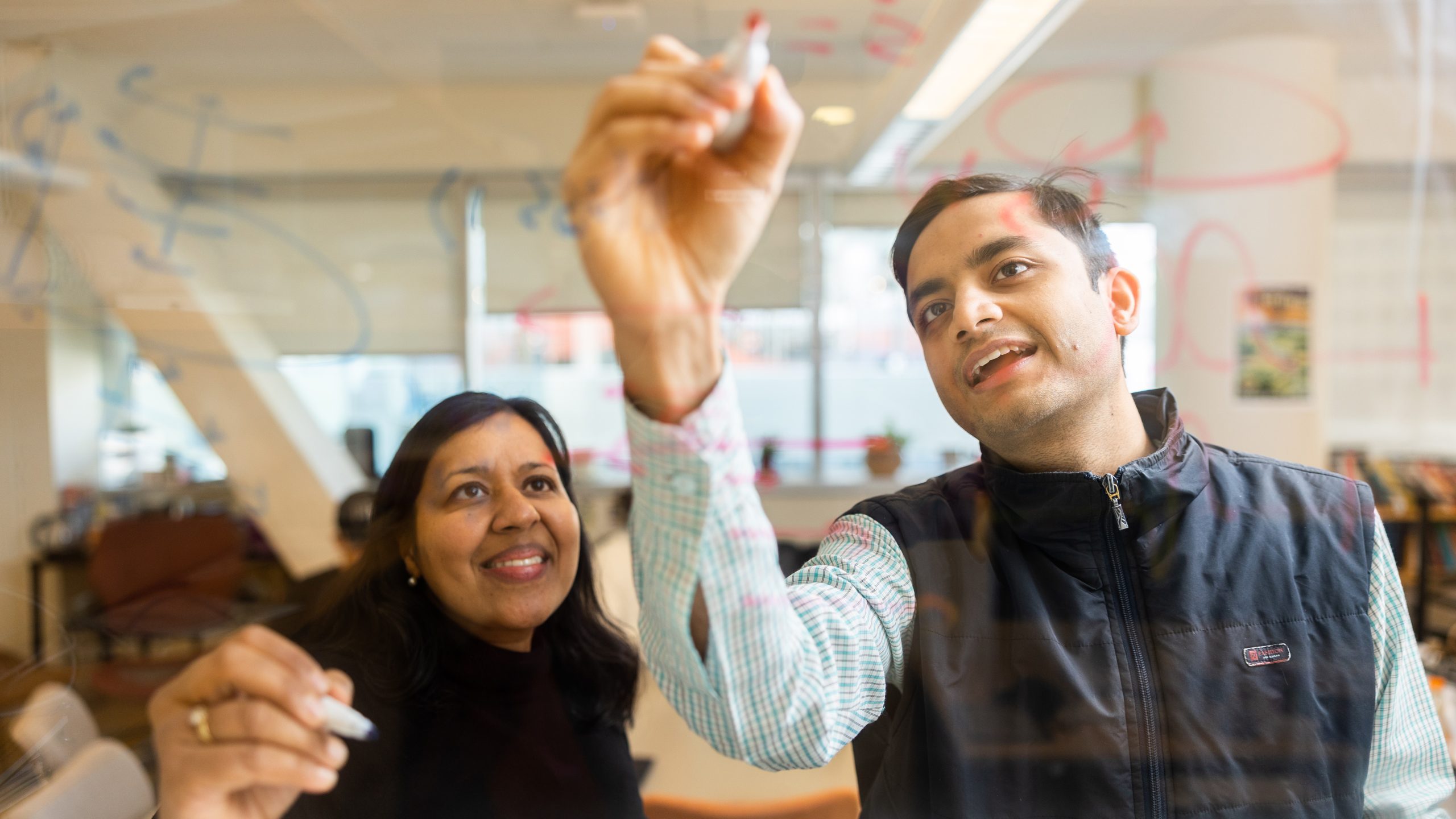Our Story
Since the McGovern Institute was established in 2000, our scientists and engineers have transformed fundamental discoveries about the brain into real-world solutions for human health. These interactive pages tell our story.
Watch our videoCelebrating 25 Years
1 Our Founders
Lore Harp McGovern and the late Patrick J. McGovern '59 establish the McGovern Institute in 2000 with the ultimate goal of understanding the brain in health and disease.
Meet our founders2 Original 6 Faculty
Emilio Bizzi, Nancy Kanwisher, Martha Constantine-Paton, Tomaso Poggio, Ann Graybiel, and Robert Horvitz make up the original six faculty members of the McGovern Institute.
Meet our current faculty3 First Publication
In 2000, Nature Neuroscience publishes a review paper on models of object recognition by McGovern Institute founding member Tomaso Poggio. Computer vision is now an area of research pursued by multiple McGovern labs.
Read the paper4 Our Director
In 2004, Robert Desimone succeeds founding director Phillip A. Sharp as director of the McGovern Institute and leads the institute for the next two decades..
Meet our director5 We Are McGovern
Hear McGovern faculty, students, and staff describe the McGovern Institute in their own words.
Watch the videoInnovation
Uniting engineering ingenuity with scientific exploration, our researchers have invented technologies that have set the global standard for brain research and its applications.
1 Breakthrough Bionics
Hugh Herr advances amputation surgery by developing a technique that preserves sensation and helps amputees better control their prosthetic limbs.
Read more2 Expansion Microscopy
Ed Boyden invents a technique that expands brain tissue, allowing researchers to see tiny structures with nanoscale resolution on standard microscopes.
Read more3 CRISPR Toolkit
Feng Zhang revolutionizes the field of biotechnology by leveraging CRISPR into a customizable toolbox for genomic manipulation in eukaryotic (animal and plant) cells.
Read more4 Stealthy Probes
Polina Anikeeva develops flexible fibers with genetic, chemical, optical, and electrical capabilities to probe the complex connections between the brain and gut.
Read More5 MRI Sensors
Alan Jasanoff invents molecular MRI sensors that monitor individual neurons and reveal how they interact. The new technology could help researchers map brain circuits with unprecedented precision.
Read more6 Mini Tech
Michale Fee miniaturizes recording equipment used to monitor neural activity in songbirds, allowing more neurons to be recorded in naturally behaving small animals.
Read more7 Baby Brains
McGovern researchers collaborate with clinicians develop a smaller MRI coil tailored specifically for children, allowing researchers to peer into the brains of children as young as one week of age.
Read moreDiscovery
Our researchers are driven by curiosity. Their fundamental discoveries have unlocked profound insights into what makes us human, paving the way for transformative advancements in health, education, and technology.
1 Cell Death
Robert Horvitz wins the Nobel Prize in 2002 for his work studying cell death in the roundworm C. elegans. His discovery is central to a wide variety of human diseases, including cancer and neurodegenerative disorders.
Read More2 Efficient Neurons
Mark Harnett finds that human neurons have a much smaller number of ion channels than the neurons of other mammals – a discovery that may help to explain the remarkable efficiency of the human brain.
Read More3 Placing Faces
By discovering regions of the brain that are devoted to specific tasks like recognizing faces, places, and body parts, Nancy Kanswisher’s work reveals fundamental truths about the human mind and intelligence.
Read More4 Motivational Circuits
Ann Graybiel shows that the brain circuits that influence our decisions, cognitive functions, and actions are connected with the circuits that give rise to our motivations - a discovery that may play a role in treating conditions like depression and addiction.
Read More5 Placebo Effect
By investigating the neural circuits that underlie placebos’ ability to elicit pain relief, Fan Wang’s discoveries have the potential to improve pain management in the future.
Read More6 Keeping Time
By studying how primates mentally measure time, Mehrdad Jazayeri discovers that the brain runs an internal clock whose speed is set by prior experience—indicating that for the brain, time is relative.
Read moreArtificial Intelligence
By leveraging the power of artificial intelligence and blending it into the fabric of our research, we have developed and tested theoretical models that challenge conventional wisdom and push the confines of what is possible.
1 Machine Vision
James DiCarlo builds and tests artificial models of the human visual system, and his research is guiding the development of human-like AI vision systems.
Read more2 Artificial Hearing
Computational discoveries from Josh McDermott’s lab explain how people hear and process sounds. His research is paving the way for more human-like AI auditory systems.
Read More3 Language vs. Thought
By combining imaging data with behavioral studies and computational models, Evelina Fedorenko shows that language is primarily a tool for communication, not for thought.
Read More4 Social Intelligence
Cognitive scientist Rebecca Saxe designs a computational model that predicts other people’s emotions — including joy, gratitude, confusion, regret, and embarrassment — approximating human observers’ social intelligence.
Read more5 Modeling Human Intelligence
Ila Fiete demonstrates that “self-supervised” computational models, which learn about their environment from unlabeled data, show activity patterns similar to the mammalian brain.
Read more6 Modeling Movement
Nidhi Seethapathi builds computational models to understand how humans move. Her findings will inform the way doctors help patients regain control over their movements after injury or stroke.
Read moreReal World Impact
From gene therapies to bionic limbs, our innovations have become actionable solutions for some of the world’s most pressing challenges. We extend our heartfelt thanks to the dedicated supporters whose generosity empowers us to understand our own minds and to create novel strategies to improve health and well-being. We are thrilled to think of the possibilities the next 25 years will bring.
1 Casgevy Gene Therapy
Just 11 years after Feng Zhang's breakthrough work adapting CRISPR-Cas9 for genome editing in eukaryotic cells, the FDA approved Casgevy, the world’s first CRISPR gene therapy for sickle cell disease.
Read more2 Brain-Controlled Prosthesis
A new surgical procedure developed in the Herr lab gives seven patients more neural feedback from their residual limb, allowing them to walk naturally and navigate obstacles.
Read more3 Shank3 Gene Therapy
By studying a protein found in synapses, Guoping Feng establishes the groundwork for a new gene therapy to treat a severe form of autism spectrum disorder.
Read more4 Mindfulness App
John Gabrieli shows that children who use a mindfulness app show improvements in several aspects of mental health, including reductions in stress and negative emotions such as loneliness and fear.
Read more5 Visualizing Tumors
Ed Boyden develops an imaging method based on expansion microscopy that could eventually be deployed to diagnose tumors, generate more accurate prognoses, and help doctors choose treatments.
Read more6 Conflict Resolution
By studying how the brain intuits what someone else is thinking, Rebecca Saxe devises possible solutions to seemingly intractable political and social conflicts.
Read moreOur Story
Since the McGovern Institute was established in 2000, our scientists and engineers have transformed fundamental discoveries about the brain into real-world solutions for human health. These interactive pages tell our story.

Our Founders
Lore Harp McGovern and the late Patrick J. McGovern '59 establish the McGovern Institute in 2000 with the ultimate goal of understanding the brain in health and disease.
Meet our founders




